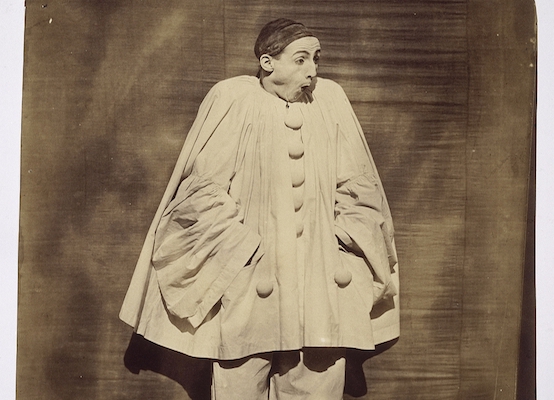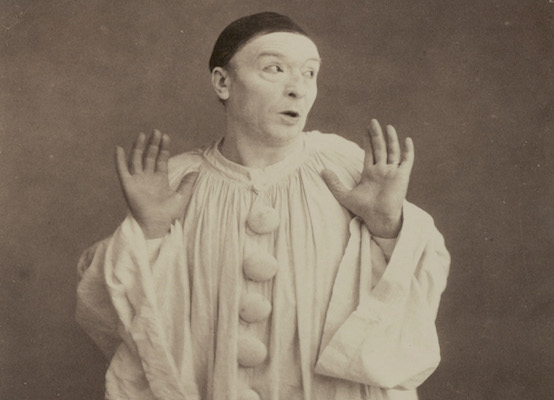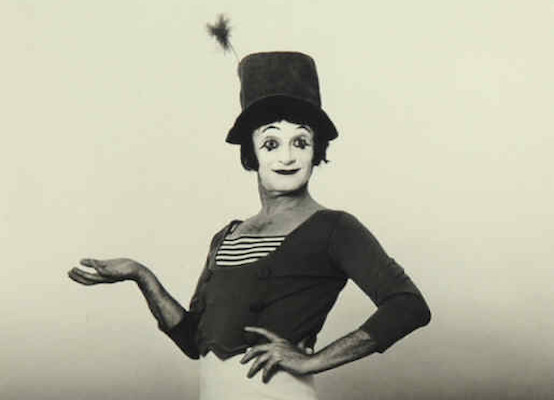- 9 août 2019
- La scène parisienne
- Anna Livesey
Mis à jour le 20 février, 2025
Si vous demandez à n’importe quel étranger d’imaginer le français le plus quintessentiel, il décrira tout de suite un moustachu au t-shirt rayé et avec un béret. Nombreux sont ceux qui ajouteront le maquillage blanc, les gants blancs, et le gros eyeliner noir. L’image qu’ils ont en tête est celle d’un mime français traditionnel, ce qui est tellement intégré comme caractère du patrimoine français, qu’il est devenu une sorte de symbole national. Le mime - qui consiste à raconter une histoire par les gestes mais sans parole - est devenu un phénomène très répandu en France, mais d’où vient ce style de performance bizarre? Qui étaient les français qui l’ont fait leur. Et à quoi ressemble le mime d’aujourd’hui? Découvrez l'histoire d'un art aussi français que le bon vin...

UNE FORME D’ART MONDIALE : LES ORIGINES DU MIME
Aujourd'hui, le mime peut être associé à des Français maquillés, mais le genre trouve en fait ses origines dans les théâtres de la Grèce antique. À l'époque, les choses étaient très différentes : les spectacles de mime étaient de simples dramatisations de scènes de la vie quotidienne, communiquées par des mouvements et des gestes élaborés, mais intégrant également la parole et quelques chants. Des variantes de cette pratique apparaissent également dans les anciens héritages théâtraux aborigènes, indiens et japonais, qui présentent tous des spectacles mêlant musique et danse à un récit raconté par des gestes et des expressions faciales stylisés. La tradition nô du théâtre masqué japonais, en particulier, a influencé de nombreux théoriciens français contemporains du mime.


LE MIME TEL QUE NOUS LE CONNAISSONS : DE L'ITALIE À LA FRANCE
Les choses ont vraiment commencé lorsque les Romains ont envahi la Grèce et ont ramené cette longue tradition théâtrale en Italie. Le mime a été absorbé dans le genre extrêmement populaire de la Commedia dell'arte, qui a prospéré en Europe du XVIe à la fin du XVIIIe siècle. Cette forme particulière d'acrobatie, de spectacle masqué et de comédie exagérée était centrée sur un ensemble de personnages fixes, jouant des sketches et des scénarios de la vie quotidienne. Une troupe itinérante d'artistes de rue a apporté la Commedia dell'arte en France en 1576, où elle s'est avérée encore plus populaire que dans son Italie natale.
Mais qu'est-ce que tout cela a à voir avec le mime moderne ? En 1816, le style théâtral italien a subi une métamorphose française grâce à un certain Jean Gaspard Deburau. Accompagné d'une troupe théâtrale composée en grande partie de ses propres enfants, Deburau est engagé par le théâtre parisien des Funambules pour présenter des numéros comiques et acrobatiques. Mais le showman a d'autres idées. Affublé d'un maquillage blanc et d'un costume à boutons tombants, il se met en scène sous les traits de Pierrot, le personnage adorable et amoureux rendu célèbre par le théâtre italien. Jusqu'à sa mort en 1846, le personnage attachant et les expressions faciales exagérées de l'acteur ravissent le public - sans qu'il ne prononce un seul mot ! Deburau a créé le mime des temps modernes.


UNE MARQUE DE FABRIQUE BIEN FRANÇAISE
Deburau est considéré comme le père du mime, mais au fil des ans, le genre a été soutenu par une longue lignée de Français au visage de craie. Après la mort de Deburau, le comédien Paul Legrand lui a succédé en tant que nouveau Pierrot au Théâtre des Funambules, donnant au personnage un caractère plus larmoyant et sentimental que l'on retrouve encore aujourd'hui dans de nombreux numéros de mime. Fidèle au maquillage blanc victorieux, Legrand a supprimé l'habit encombrant de son prédécesseur et a souvent choisi de se produire dans ses vêtements ordinaires (béret et bande bretonne, par exemple). Puis, au XXe siècle, des praticiens du théâtre français comme Jacques Lecoq et Étienne Decroux ont joué un rôle central dans le développement du mime en tant que genre artistique formel. Les deux écrivains ont publié des explorations théoriques détaillées sur le sujet.
Enfin, le mime français le plus connu de ces dernières années est sans doute Marcel Marceau, dont les représentations de son personnage, "Bip le clown", ont connu un succès international. Marceau a même mis son numéro de mime au service de la Résistance française pendant la Seconde Guerre mondiale. Se présentant silencieusement sous le nom de Bip, le mime a fait taire pendant des heures des groupes d'enfants juifs qui s'échappaient de la France occupée pour se réfugier en Suisse.

LES FILMS AVANT LES TALKIES : MIME ET CINÉMA
Enfant, Marceau s'est formé à l'art du mime en regardant des films - ceux de Charlie Chaplin, pour être précis. Avant le cinéma parlant et l'introduction du son dans la pellicule, les contraintes technologiques font que le mime règne sur le grand écran. Des acteurs comme Charlie Chaplin et Buster Keaton sont devenus les derniers descendants de cette ancienne tradition, mais sans la peinture du visage ! Ils ont adopté l'art de leurs prédécesseurs mimes, racontant une histoire uniquement par le langage corporel et les gestes. En France, l'acteur et cinéaste iconique Jacques Tati s'est d'abord fait connaître en tant que mime. Il a ensuite intégré cette forme d'art dans nombre de ses films, dont l'humour provient plus souvent de gags visuels savamment chorégraphiés que de dialogues.


FLASH AU PRÉSENT : LE MIME AUJOURD'HUI
Depuis ses origines dans l'Italie du 15e siècle, le mime est lié aux spectacles de rue et à la vente ambulante. Aujourd'hui, vous pouvez trouver des artistes de mime se produisant devant des foules de spectateurs dans différentes villes du monde. Mais le genre reste également très apprécié du public au théâtre. Après avoir connu le succès lors de son passage dans l'émission America's Got Talent, le comédien Sam Wills, plus connu sous le nom de Tape Face, a fait le tour du monde avec son hilarant numéro de mime contemporain. Avec une bande de ruban adhésif sur la bouche et beaucoup de cœur, Tape Face peut faire rire son public sans prononcer un seul mot.
De retour en France, le duo sensationnel Los Guardiola monte sur scène à Paris. Sans un mot prononcé, Los Guardiola nous emportent dans un voyage émotionnel à travers sept rêves distincts. Grâce à une maîtrise impressionnante du corps, ils explorent les thèmes universels de l'amour, de la perte, de la joie et de la mélancolie. Leur danse, mélange de tango, de mime et de théâtre gestuel, est à la fois poétique et très puissante. Réservez vos billets dès maintenant !
Liked this article? Get more Parisian theatrical history from the Theatre in Paris blog:
- Why Are We Clapping? A History of Applause
- The Spectacular History of Paris' Cabarets
- 10 Mysteries Behind the Magnificent Opéra Garnier
ET IL Y EN A ENCORE BIEN PLUS À DÉCOUVRIR...
Que vous soyez un fan aguerri ou que vous ayez une envie de découverte, la newsletter de Theatre in Paris saura vous aiguiller ! Une fois par mois ou plus, vous recevrez un e-mail spécialement rédigé par nos soins avec notre sélection du moment, nos meilleurs conseils, les promotions en cours, et bien plus !
Vous pouvez également nous suivre sur Facebook, Instagram, Pinterest et TikTok en cliquant sur le lien ci-dessous pour voir notre page Link in Bio...





